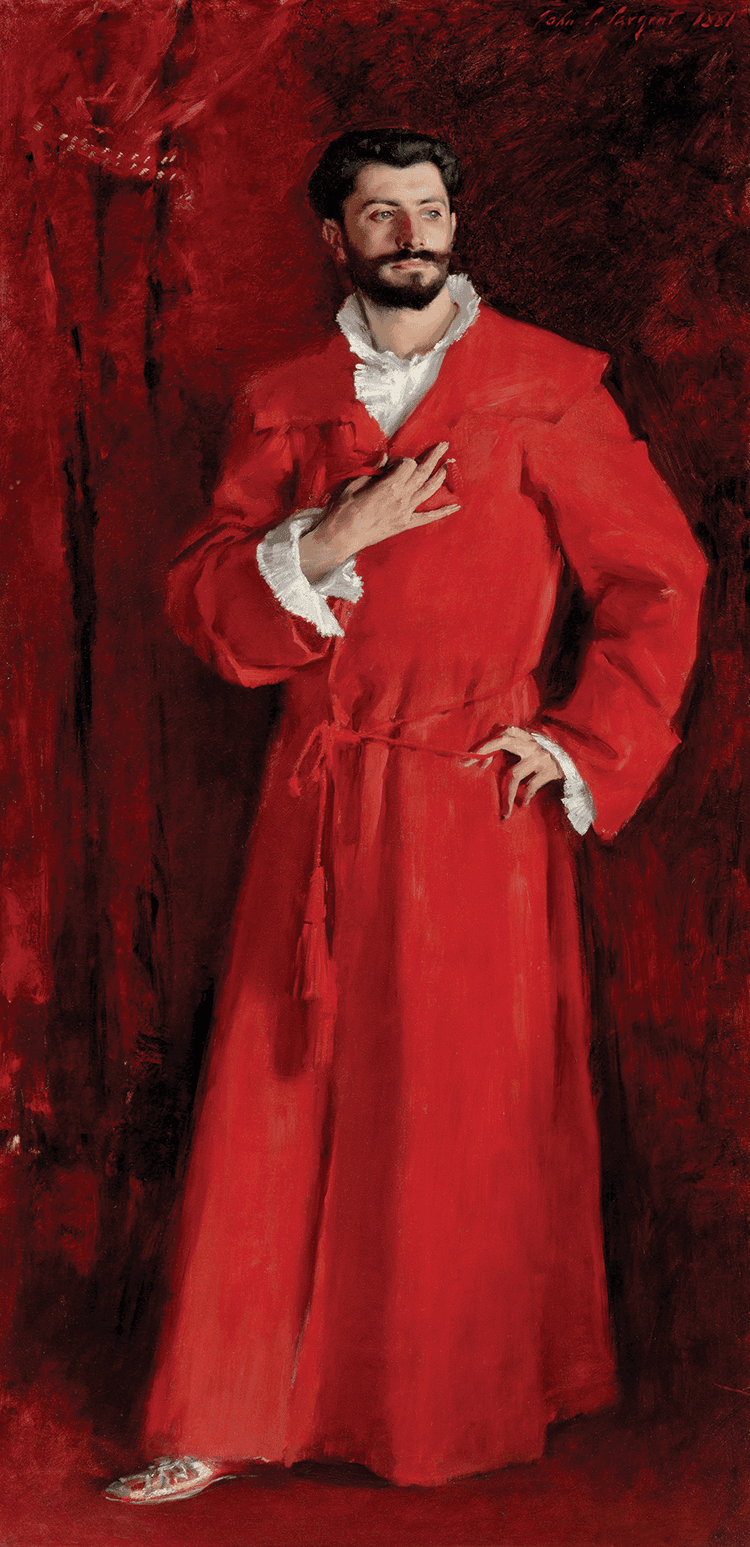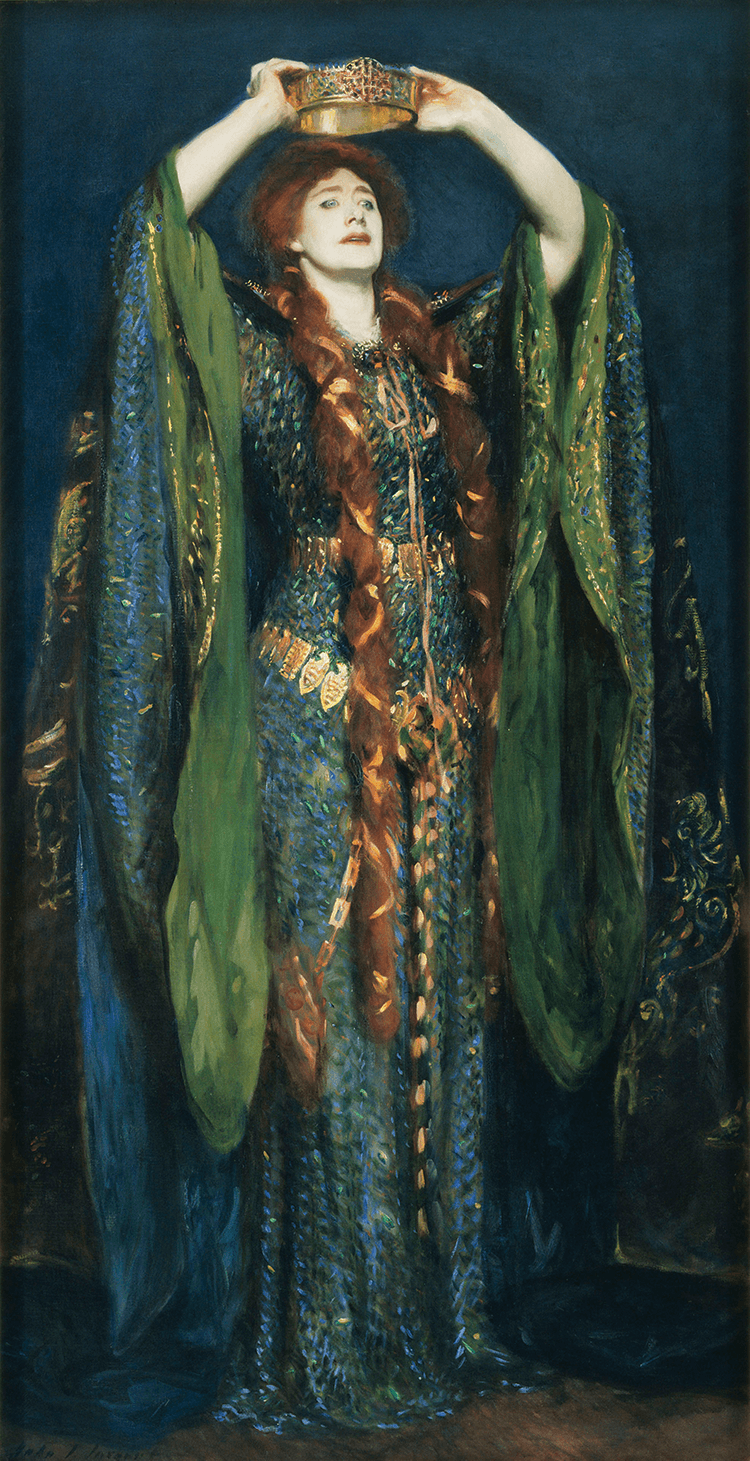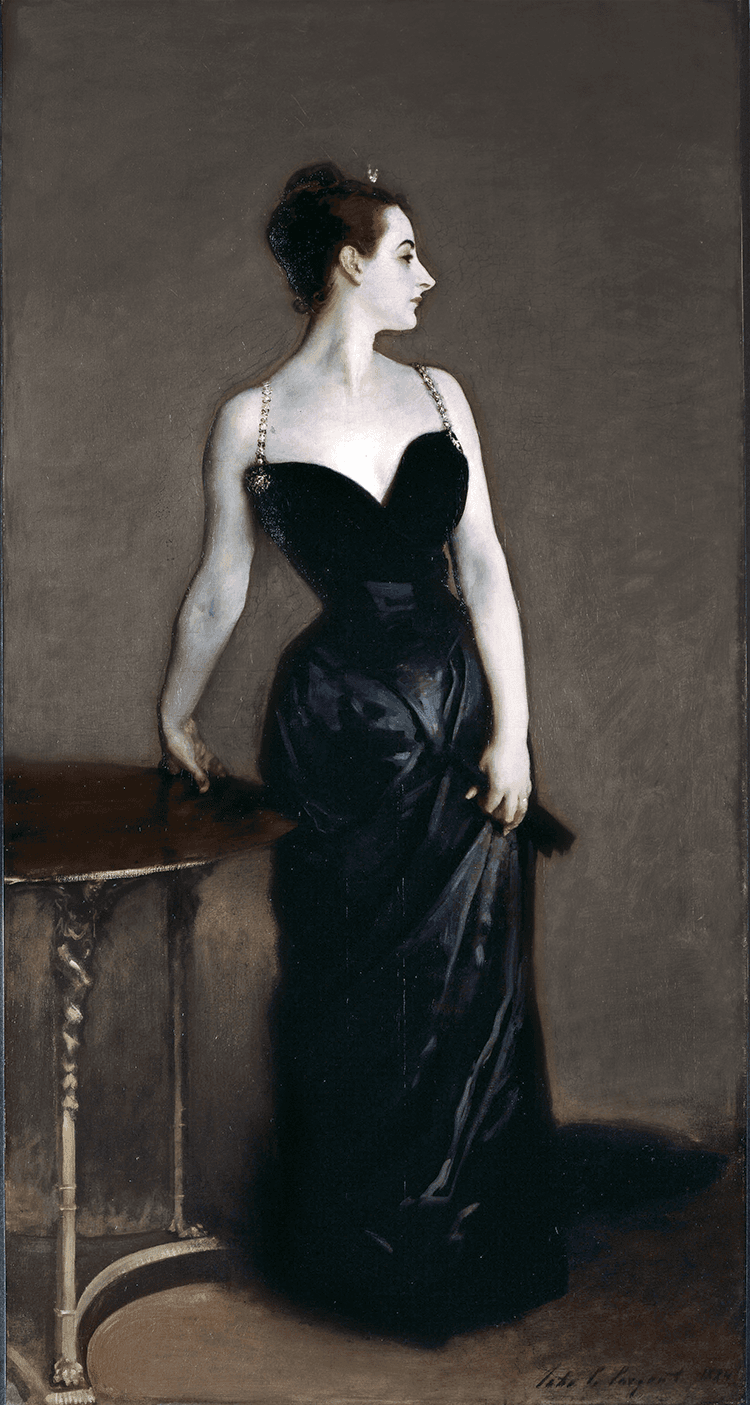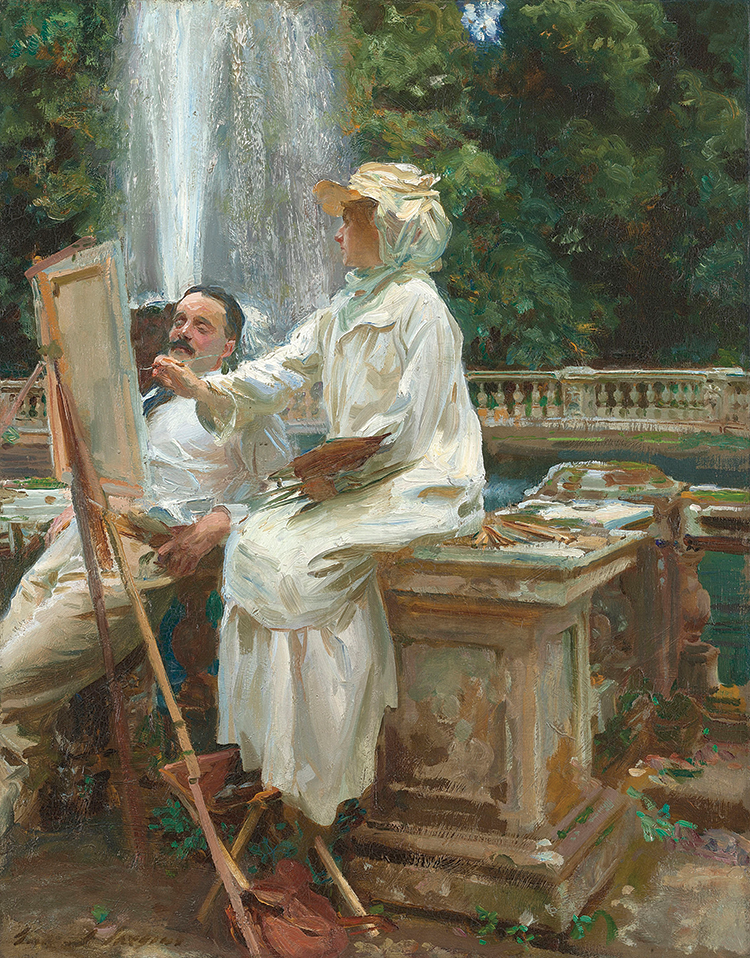John Singer Sargent: Portraits of Artists and Friends
John Singer Sargent (1856–1925), the leading American portraitist of his generation, painted exceptional images of actors, artists, dancers, musicians, and writers. Throughout his transatlantic career, Sargent was inspired by these artistic individuals—many of whom were his friends—and made them the subjects of his most daring and unconventional portraits.
This dazzling painting shows four of Sargent’s friends asleep in an Alpine meadow on the Italian side of the Matterhorn. The figures are so intermingled with each other and the landscape that it is difficult to differentiate between them. At left, two women, Dos Palmer (ca. 1879–1961) and Lillian Mellor (b. ca. 1881–?), nap beneath white parasols. To the right, Leonard (“Ginx”) Harrison (1870–1939) dozes with his head in Mellor’s lap next to his brother, the painter Lawrence (“Peter”) Harrison (1866–1937). While the sensuality of the scene shows scant regard for contemporary propriety, viewers might have been shocked to learn that Palmer, the daughter of an American tycoon, was Peter Harrison’s longtime mistress. The utter relaxation of the group contrasts with Sargent’s alert observation. The cropped and foreshortened composition enhances the voyeuristic aspect of the scene. Viewed up close, broadly painted passages evoke the sense of dappled sunlight and dissolve into near abstraction.
Hammer Museum, Los Angeles, Armand Hammer Collection, Gift of the Armand Hammer Foundation Samuel-Jean Pozzi (1846–1918) was a pioneer in the field of modern gynecology in France; his practices advanced the reproductive safety and dignity of women. He was also an aesthete and an art collector whom Sargent greatly revered. The artist’s admiration for his charismatic sitter is evident in this dramatic portrait. Sargent portrays the worldly man in an almost ecclesiastical mode, with a gracious, slightly mannered pose and crimson costume that reference images of popes and cardinals by the old masters. Pozzi’s long fingers and elegant hands suggest his surgical prowess but also hint at his sensuality, which is further evoked by his informal dressing gown and the lush velvet curtains. This portrait was the first work Sargent exhibited at the Royal Academy in London in 1882.
Tate, United Kingdom, Presented by Sir Joseph Duveen, 1906 Famed Shakespearean actor Ellen Terry (1847–1928) played the role of Lady Macbeth in Henry Irving’s production at the London Lyceum beginning in December 1888. Sargent admired her performance and costume and convinced her to pose for him. He shows Terry placing a crown on her head after the murder of Duncan, the Scottish king. The incident does not occur in Shakespeare’s text, nor was it a part of the performance. Sargent, however, sought a dramatic motif to make his portrait convincing, both as the personification of a role and as the characterization of an individual actor. Terry’s intense and powerful gaze enhances this climactic moment. Alice Comyns Carr, a close friend of the artist, designed Terry’s spectacular costume, using green silk and blue tinsel adorned with thousands of beetle wings to make the actor look like a serpent. Sargent captured the iridescent effect with impressionistic dabs of pigment.
Charles-Émile-Auguste Durand (1837–1917), known as Carolus-Duran, was a celebrated figure in the world of Parisian art and theater. Known for his elegant society portraits, he was also highly influential as a teacher. Sargent entered Duran’s studio in 1874 and became his star pupil. Duran’s approach was radical: he encouraged his students to draw and paint simultaneously, using a loaded brush. In this stylish portrait, which received an award when it was shown at the Paris Salon in 1879, Sargent pays homage to his teacher by embracing his fluid technique. The affectionate dedication to Duran, inscribed in French at the upper right, announces Sargent’s artistic pedigree but also caused some contemporary viewers to remark that the student had surpassed the master.
Sargent usually presented the sketches he made of friends and fellow artists to them as gifts, as was the tradition in artistic circles. This sketch of Claude Monet (1840–1926) is an exception. It remained with Sargent all his life and was in his studio when he died, along with several works by Monet that Sargent collected. Monet is shown sitting at an easel painting a landscape outdoors. This portrait has assumed an importance in the history of Impressionism because it shows the French artist doing what he advocated, painting directly from nature. It certainly had a personal significance for Sargent, who greatly admired Monet, as it commemorates their artistic relationship.
Virginie Avegno Gautreau (1859–1915), an expatriate from Louisiana, was a familiar figure in Parisian society, known for her artful appearance, which she accentuated with dramatic cosmetics and clothing. She fascinated Sargent, who undertook this portrait without a commission, hoping to enhance his reputation by exhibiting it at the Salon. The portrait, which emphasizes Gautreau’s egotism and glamour and exaggerates her daring style (the right strap of her gown was originally shown slipping from her shoulder), shocked many viewers. In 1884, critic Louis de Fourcaud recognized the portrait as a description of a new type of woman who used her appearance to acquire celebrity and social standing. Like an artist or an actor, the “professional beauty” enacted a role in Parisian society, which Sargent sought to record in this image. After the Salon, Sargent repainted the shoulder strap and kept the picture.
Sargent usually presented the sketches he made of friends and fellow artists to them as gifts, as was the tradition in artistic circles. This sketch of Claude Monet (1840–1926) is an exception. It remained with Sargent all his life and was in his studio when he died, along with several works by Monet that Sargent collected. Monet is shown sitting at an easel painting a landscape outdoors. This portrait has assumed an importance in the history of Impressionism because it shows the French artist doing what he advocated, painting directly from nature. It certainly had a personal significance for Sargent, who greatly admired Monet, as it commemorates their artistic relationship.
Sargent first met Italian painter Ambrogio Raffele (1845–1928) at Purtud in the Val d’Aosta, Italy, in the summer of 1903. Raffele enjoyed a long career as a landscape and figurative artist, working in a vigorous, naturalistic style akin to Sargent’s. Here, he is shown in the cramped conditions of his bedroom at Purtud with a large landscape of trees and cattle propped between the washstand and the bed. Paradoxically, the artist, who is known for working outdoors, is shown constructing a painting from preliminary studies in his makeshift studio. Raffele peers through the fingers of his right hand at a small sketch held in the other along with a palette and fistful of brushes, as he contemplates his next move. Sargent’s brilliant rendering of light on the rumpled sheets of the unmade bed fills nearly half the canvas.
Jane de Glehn (1873–1961) is shown sketching beside the great fountain of the Villa Torlonia in Frascati outside Rome, watched by her husband, Wilfrid (1870–1951). The pool, enclosed within a magnificent balustrade, lies at the top of a spectacular cascade that falls down the hillside to a Renaissance villa. Jane is alert and focused as she places a brushstroke on the canvas, her feet resting on a fold-up stool. In contrast, Wilfrid, relaxed and idle, leans back, his thumbs caught in his belt. The figure of Wilfrid balances the composition and introduces both a narrative element and a mood of intimacy.
The majority of these works were not commissioned and were therefore often more highly charged, intimate, and experimental than Sargent’s formal portraiture. They are at once penetrating character studies and records of relationships, aspirations, and allegiances. In some instances, these personal works display elements of self-portraiture.
Sargent was deeply engaged in the culture of his time, always open to new influences, and able to nurture friendships with those he admired. He had a broad and eclectic interest in contemporary art and literature and was a gifted pianist and a passionate musicologist. He befriended many creative types, including writers Henry James and Robert Louis Stevenson, artists Claude Monet and Auguste Rodin, and composer Gabriel Fauré, among others. These diverse friendships linked Sargent to the vanguard of contemporary movements in the arts and shaped his dynamic creative vision and artistic practice.
About ninety portraits are brought together in the exhibition Sargent: Portraits of Artists and Friends, which is on view at The Metropolitan Museum of Art through October 4, 2015. An exhibition catalogue is available for sale at the museum store. For information and to order a copy of the catalogue, visit www.metmuseum.org or call 212. 535.7710. The exhibition is made possible by The Marguerite and Frank A. Cosgrove Jr. Fund and is organized by the National Portrait Gallery, London, in collaboration with The Metropolitan Museum of Art.
This article was published in the Autumn 2015 issue of Antiques & Fine Art magazine, a digitized version of which is available onAFAmag.com. Antiques & Fine Art and AFAmag are affiliated with InCollect.com.

















































